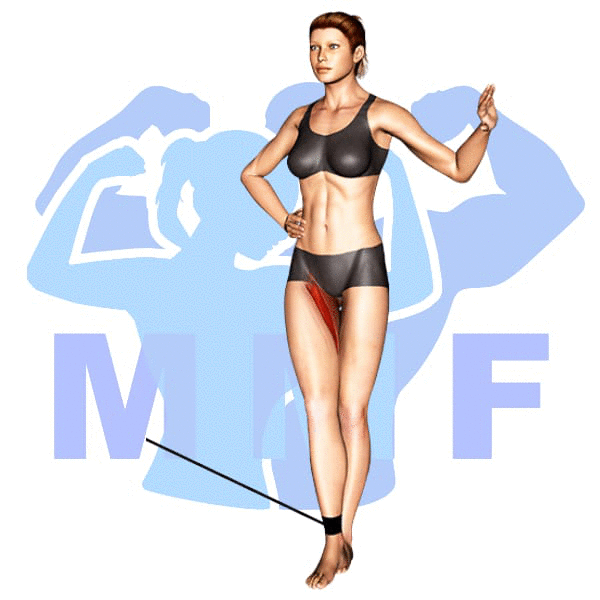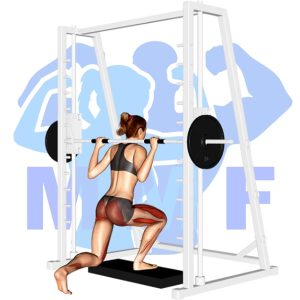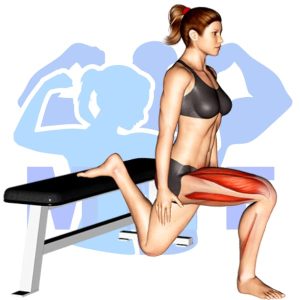Are you struggling to target your inner thigh muscles? Do you find traditional exercises like squats and lunges just aren’t cutting it? We’ve all been there. The adductors, or inner thigh muscles, can be a tricky area to tone and strengthen. But fear not, because there’s a common reason for this struggle: lack of resistance. By adding resistance to your adductor exercises, you can effectively target and engage those muscles. In this post, we’ll explore the solution to this problem: using resistance bands for adductor exercises.
Resistance Band Adductors Summary
- Primary Muscles: Hip Adductors
- Secondary Muscles: Gluteus Maximus – Lower Fibers, and Gracilis, Pectineus
- Equipment: Resistance Band and Door Anchor
- Mechanics Type: Isolation
- Force: Pull
- Utility: Auxiliary

Resistance Band Adductors Instructions
- Attach each side of the resistance bands each of your ankles and attach the center to the door anchor. Place the anchor near the bottom of the door.
- Stand with your base leg hip not being worked away from the door. You can brace against the door jam your hand on the side that is doing the exercises.
- Before you begin you want the band to be tight so that there is resistance at the beginning of the movement. If the band is not tight, you can Pull the band attached to your support leg and stand on it to increase the resistance.
- Start with your moving leg straight and extended towards the door.
- Next, pull your moving leg across in front of your base leg. You should only be pivoting at your hip with both legs straight.
- Once you have crossed your legs as far as you can with good form, hold for a second.
- Next, slowly bring your leg back across the support leg and towards the anchor.
- Repeat for your desired repetitions, usual 8-12.
Video Tutorial
Resistance Band Adductors Muscles
Target (Agonist)
- Hip Adductors
Synergists
- Gluteus Maximus – Lower Fibers
- Gracilis
- Pectineus
Dynamic Stabilizers
- None
Stabilizers
- Hip Adductors (opposite)
Antagonist Stabilizers
- None

Benefits of Resistance Band Adductors
The Resistance Band Adductors exercise is an effective way to target the hip adductors, a group of muscles that are often neglected in traditional strength training and fitness routines. When performing this exercise, the hip adductors are engaged in both the concentric and eccentric phases of the exercise, providing a more complete workout than other adductor exercises. Additionally, because of the low-impact nature of this exercise, it can be performed by individuals of any fitness level without fear of injury. The Resistance Band Adductors exercise can also be easily modified to provide a greater or lesser challenge, depending on the user’s strength level.
Tips for Performing Resistance Band Adductors
For you to have the optimal improvements when training implement these essential tips. Furthermore, if you would like to avert injuries, use these tips.
- Keep Your Back Straight. If you feel like you need to bend for balance grab a chair instead to keep your balance.
- Check your form by either using a mirror or recording yourself with your phone.
- Keep your toes pointed forward, if you rotate your hips you will be using your abs and not your adductors.
- Pause and squeezer your adductors with your legs crossed for a second. Specifically, by adding this pause you are forcing your muscle to activate.
- Concentrate On Inhaling And Exhaling. For this and most workouts, breathing is very important. You should undoubtedly be breathing out during your target muscle contraction and inhaling when the target muscles are expanding.
- Slow Each Repetition Down For Improved Strength Gains. By Raising the time under tension, you are engaging your muscles more, and they will respond by gaining more muscle. You can achieve this without increasing the resistance by doing slow reps approximately 4 – 6 seconds contraction and pause then 4 – 6 seconds expanding.
Benefits and Tips Video
Frequent Mistakes To Avoid
You need to keep from making these standard mistakes to maintain good form and reaching your goals. Additionally
- Avoid swinging your leg and not pausing. You want to activate your Adductors on every rep, not be a pendulum.
- Don’t bend your knee. Keep both your quads and glutes flexed will help prevent injuries. For instance, if you bend your knee you will put undue pressure on your anterior cruciate ligament (ACL) and posterior cruciate ligament (PCL).
Find More Resistance Band Exercises Here
Variations and Complementary Exercises
For those looking to switch things up or add additional exercises to their routine, there are many variations, complementary, and alternative exercises that can be used in place of or in addition to Resistance Band Adductors. These exercises will work similar muscles as the Resistance Band Adductors, while adding variety and challenge to your workout. Below are some of the best alternatives.
Hip Adduction

Hip adduction is a complementary or alternative exercise to resistance band adductors. It works the same muscles, but requires no external equipment. To perform hip adduction, stand with feet together and slightly bent at the knees. Keeping the back straight and core engaged, slowly move the legs outwards, allowing them to move as far apart as possible while still keeping the feet flat on the floor. Then, use your inner thigh muscles to bring your legs back together. This exercise can be made more difficult by holding dumbbells at the sides of your body or by increasing the number of repetitions.
Squat

Squat is an excellent exercise to complement or substitute for Resistance Band Adductors. Squat works the lower body muscles and core, which is the same area that is targeted by Resistance Band Adductors. Squat also engages the glutes, hamstrings, and quads, which are all important muscles in the hips and thighs that are worked by adduction exercises. It can be done with or without weights and is easy to modify to increase or decrease intensity. Squat is a great way to add variety to your workout routine and will help you build strength, balance, and flexibility.
Smith Machine Rear Lunge

Smith Machine Rear Lunge is a great complementary or alternative exercise for Resistance Band Adductors. This exercise works the glutes, hamstrings, and core muscles while also targeting the inner thighs. It is performed by standing behind a Smith machine, gripping the bar with both hands, and lunging back with one leg. The leg should be bent at a 90-degree angle at the bottom of the lunge and then return to the starting position. This exercise can be done with light weights to start, and then increased as needed for added resistance. It can also be done without weights for an effective bodyweight option. Smith Machine Rear Lunges are great for improving hip stability, coordination, balance, and strength.
Check Out These Top Resistance Band Exercises
Plyo Split Squats

Plyo Split Squats are an excellent complementary exercise for Resistance Band Adductors, as they involve similar movements. The exercise requires you to stand with one foot forward and the other back, then jump and switch feet in the air, landing with the opposite foot forward. Plyo Split Squats are a great alternative for Resistance Band Adductors because it engages multiple muscle groups, including the glutes, quads, and calves, while still targeting the adductor muscles. Additionally, this exercise is a great way to increase power and explosiveness, making it an ideal choice for athletes looking to improve their performance.
Half Squat

Half Squat is a great complementary or alternative exercise for Resistance Band Adductors. It works the same muscles as the Adductors, but with a different angle of attack. Half Squat targets the inner thigh, outer thigh, and core muscles all at once. It also helps to increase flexibility and mobility in the hips and lower body, which helps to improve posture and balance. This exercise can be done with either bodyweight or added weight for an extra challenge. To perform this exercise, start by standing with feet shoulder-width apart and lower your body down into a half squat position. Make sure to keep your weight in your heels and your back straight. Hold the position for a few seconds before returning to the starting position. This exercise can be repeated for the desired number of reps.
Bulgarian Split Squat

The Bulgarian Split Squat is an excellent complementary or alternative exercise to the Resistance Band Adductors. It helps to strengthen the same muscles, while also providing an additional challenge to the core and balance. To perform the Bulgarian Split Squat, stand in a split stance with one foot on a bench behind you and the other foot on the floor. Lower your back knee towards the floor, keeping your chest up and your core tight. Push back up through your front heel to return to the starting position. This exercise is great for targeting the adductors and improving balance and stability.
Find More Legs Exercises Here
Opposing Complementary Exercises
When using the exercise Resistance Band Adductors, it’s important to also include exercises that work the opposing muscle groups to ensure that you are creating a balanced workout and avoiding muscular imbalances. To help support your adductor workout, here are a few exercises that target the opposing muscle groups:
Hip Abduction

Hip Abduction is a great complement to Resistance Band Adductors as it works the opposing muscle group. It works the gluteus medius, gluteus minimus, and tensor fasciae latae muscles which are responsible for abducting the leg away from the midline. It can be done in a standing or lying position with bands, cables, or bodyweight. It helps to build strength and stability in the hip and pelvis, improving balance and coordination. By doing Hip Abduction and Resistance Band Adductors together, you will be strengthening both sets of muscles in the hip, providing a balanced approach to your exercise routine.
Toes Out Hip Abduction

Toes Out Hip Abduction is a great way to complement Resistance Band Adductors by targeting the opposing muscle group. This exercise works the abductors, which are the muscles located on the outside of your hips that help you move your legs away from your body. Toes Out Hip Abduction is a great way to strengthen these muscles, which can help to improve stability and balance. By doing both exercises, you’ll be working both muscle groups and helping to create an overall stronger, more balanced lower body.
Toes In Hip Abduction

Toes In Hip Abduction is a great exercise to complement Resistance Band Adductors. This exercise targets the glutes and outer hip muscles, which are the opposing muscle group of the adductors. Toes In Hip Abduction helps to build strength and stability in the hips, improve posture, and balance the muscle groups around the hips. It also helps to prevent injuries caused by over-stretching or overworking one muscle group. This exercise can be done using a resistance band or bodyweight, and can be modified for all levels of fitness. By doing both exercises, you can create a balanced workout that will keep your hips strong and healthy.
Tone Your Legs: Add Resistance Band Adductors to Your Workout Today!
If you’re looking to ramp up your leg workout, consider adding resistance band adductors to your routine. These bands provide resistance against your inner thighs, helping to tone and strengthen those often overlooked muscles. Not only can this lead to increased strength and stability, but it can also improve your overall balance and posture. Plus, the bands are compact and easy to pack in your gym bag or take with you on the go. So why not give resistance band adductors a try and feel the burn next time you hit the gym?
References: Wikipedia | ExRx.net | PubMed.gov | Comprehensive List of Legs Resistance Band Exercises

